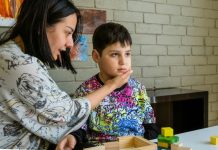
A recent study co-led by researchers at UCLA Health has discovered distinct brain connectivity patterns in six-week-old infants at risk for developing autism spectrum disorder (ASD).
These findings, published in Communications Biology, suggest that differences in brain responses emerge much earlier than ASD-related behaviors can be identified.
The researchers believe these early brain patterns may contribute to the development of ASD-related behaviors by altering typical brain changes that guide social development.
The study examined 53 infants, 24 of whom had a higher likelihood of developing ASD because they had at least one older sibling with an ASD diagnosis.
The other 29 infants had no family history of ASD or other developmental disorders. Prior research indicates that the risk of developing ASD is approximately 20% for infants with an older sibling with the condition.
The researchers focused on the Salience Network, a collection of brain regions that detect and filter important stimuli from the environment and direct attention accordingly. This network is essential for identifying which stimuli are worthy of attention, facilitating appropriate responses.
The study found that high-likelihood infants showed stronger connections between the Salience Network and sensorimotor regions of the brain, which are involved in processing sensory information and movement.
In contrast, infants with a typical likelihood of developing ASD had stronger connections between the Salience Network and prefrontal regions, which are crucial for social attention and interactions.
Furthermore, infants with stronger connectivity to sensorimotor regions exhibited weaker connectivity to prefrontal regions, suggesting that greater attention to basic sensory information may come at the expense of attention to socially relevant information.
These early brain patterns observed at six weeks predicted behavior at age one.
Infants with greater connectivity with sensory regions demonstrated significant sensory over-responsivity at age one, a condition common in autism where individuals show extreme responses to typical environmental sounds or sensations.
Conversely, infants with more connectivity to social attention regions exhibited better ability to share attention with others at age one, an important precursor to developing the social and communication skills often impaired in autism.
The authors believe these early brain connectivity patterns could help explain the reduced social attention and atypical sensory processing commonly seen in ASD.
Despite the modest sample size and the single timepoint for evaluating Salience Network connectivity, the study strongly suggests that atypical patterns of Salience Network connectivity may reflect a developmental vulnerability.
The authors recommend that this possibility be examined in large-scale longitudinal studies that heavily sample brain and behavioral measures during the first postnatal years.
An emerging theory in autism research is that differences in sensory processing may precede the more classic social and communication symptoms of autism.
This study supports that theory by showing that very early brain differences related to how attention is allocated may predict both sensory and social behaviors in toddlers.
Dr. Shulamite Green, assistant professor at the David Geffen School of Medicine at UCLA and corresponding author, explains that more attention to extraneous sensory stimuli in the environment could make it difficult to attend to social cues, affecting how the brain develops across the first year of life and beyond.
Dr. Mirella Dapretto, co-author and associate director of the Semel Institute for Neuroscience and Human Behavior, finds these findings compelling.
She notes that they provide both a mechanistic and theoretical account for the lack of typical attentional biases for social stimuli seen in older infants and toddlers who later receive an ASD diagnosis.
These early indicators offer valuable insights into the origins of ASD-related behaviors, potentially paving the way for earlier interventions and support.
If you care about autism, please read studies about a new cause of autism, and cats may help decrease anxiety for kids with autism.
For more information about health, please see recent studies about vitamin D that may hold the clue to more autism, and results showing strange eating habits may signal autism.
The research findings can be found in Communications Biology.
Copyright © 2024 Knowridge Science Report. All rights reserved.



